Evaluating the Balancing Properties of Wind and Solar Photovoltaic System Production
Abstract
1. Introduction
2. Data and Methods
3. Results
4. Discussion
5. Conclusions
Author Contributions
Funding
Data Availability Statement
Acknowledgments
Conflicts of Interest
Appendix A
| Parameter | Indication |
|---|---|
| Sensor/Transducer type | Cup anemometer/Optico-chopper |
| Measuring range | 0.4…75 m/s |
| Starting threshold | <0.5 m/s |
| Accuracy (within 0.4…60 m/s), with characteristic transfer function | ±0.17 m/s |
| With “simple transfer function” Ut = 0.1 × R | ±0.5 m/s |
| Parameter | Indication |
|---|---|
| Sensor/Transducer type | Vane/Optical code disc |
| Measuring range | 0…360° |
| Starting threshold | <0.4 m/s |
| Resolution | 5.6° |
| Accuracy | Better than ±3° |
| Setting time after power turn-on | <100 µs |
| Dealy distance | 0.4 m |
| Parameter | Indication |
|---|---|
| Spectral range (50% points) | 285 to 2800 nm |
| Sensitivity | 7 to 14 µV/W/m2 |
| Response time (95%) | <5 s |
| Zero ofset A | <±7 W/m2 |
| Zero ofset B | <±2 W/m2 |
| Directional response (up to 80° with 1000 W/m2 beam) | |
| Temperature response (−20 to ±50 °C) | <±1% |
| Operational temperature | −40 °C to +80 °C |
| Maximum solar irradiance | 4000 W/m2 |
| Fielf of view | 180° |
| Parameter | Indication |
|---|---|
| Observation range | WMT701: 0….40 m/s |
| Starting threshold | 0.01 m/s |
| Resolution time | 250 ms |
| Accuracy | 0…75 m/s ±0.1 m/s or 2% of reading, whichever is greater |
| Observation range | 0…360° |
| Starting threshold | 0.1 m/s |
| Resolition | 0.01° |
| Response time | 250 ms |
| Accuracy | ± 2° |
| Observation range | WMT701: 0….40 m/s |
References
- Benhacene, H.L.M.; Hussien, A.M. The Impact of Adopting Renewable Energy Resources on Sustainable Development in Saudi Arabia: A Qualitative View. Sustainability 2025, 17, 768. [Google Scholar] [CrossRef]
- Kies, A.; Schyska, B.; Von Bremen, L. The Demand Side Management Potential to Balance a Highly Renewable European Power System. Energies 2016, 9, 955. [Google Scholar] [CrossRef]
- Shen, C.-L.; Shen, Y.-S. Output Filter Design for a Novel Dual-Input PV-Wind Power Converter by Energy Balance Principle. Appl. Sci. 2016, 6, 263. [Google Scholar] [CrossRef]
- Boubii, C.; El Kafazi, I.; Bannari, R.; El Bhiri, B.; Bossoufi, B.; Kotb, H.; AboRas, K.M.; Emara, A.; Nasiri, B. Synergizing Wind and Solar Power: An Advanced Control System for Grid Stability. Sustainability 2024, 16, 815. [Google Scholar] [CrossRef]
- Frimpong, S.O.; Agbehadji, I.E.; Abayomi, A.; Millham, R.C.; Freeman, E.; Ujakpa, M.M. Economic and Reliability Determination of Sustainable Renewable Energy Mix Based on Social Spider Prey Optimization Algorithm. Soft Comput. 2023, 27, 10687–10718. [Google Scholar] [CrossRef]
- Syed, A.S.; Patrick, A.; Lauf, A.; Elmaghraby, A. Assessing the Complementarity of Wind and Solar Energy in Kentucky. Energies 2024, 17, 3226. [Google Scholar] [CrossRef]
- Larsen, M.A.D.; Bournhonesque, J.; Thiery, W.; Halsnæs, K.; Hattermann, F.F.; Hoff, H.; Salack, S.; Adenle, A.; Liersch, S. Renewable Energy Planning in Africa: Robustness of Mean and Extreme Multi-Model Climate Change Patterns in Solar PV and Wind Energy Potentials. Environ. Res. Commun. 2024, 6, 15001. [Google Scholar] [CrossRef]
- Pierro, M.; Barba, M.; Perez, R.; Perez, M.; Moser, D.; Cornaro, C. Ancillary Services via Flexible Photovoltaic/Wind Systems and “Implicit” Storage to Balance Demand and Supply. Solar RRL 2023, 7, 2200704. [Google Scholar] [CrossRef]
- Belhadef, O.; Merahi, F.; Badoud, A.E. Energy Management Systems for Hybrid Renewable Energy Systems: A Comprehensive Review. In Proceedings of the 2024 2nd International Conference on Electrical Engineering and Automatic Control (ICEEAC), Setif, Algeria, 12–14 May 2024; pp. 1–6. [Google Scholar]
- Benato, A.; De Vanna, F.; Stoppato, A. Levelling the Photovoltaic Power Profile with the Integrated Energy Storage System. Energies 2022, 15, 9521. [Google Scholar] [CrossRef]
- Niu, X.; Luo, X. Policies and Economic Efficiency for Distributed Photovoltaic and Energy Storage Industry. Distrib. Gener. Altern. Energy J. 2023, 38, 1197–1222. [Google Scholar] [CrossRef]
- Ho-Tran, L.; Fiedler, S. More Summertime Low-Power Production Extremes in Germany with a Larger Solar Power Share. Solar Energy 2024, 283, 112979. [Google Scholar] [CrossRef]
- Fasihi, M.; Weiss, R.; Savolainen, J.; Breyer, C. Global Potential of Green Ammonia Based on Hybrid PV-Wind Power Plants. Appl. Energy 2021, 294, 116170. [Google Scholar] [CrossRef]
- Dietrich, U. Zero-Energy Buildings in Cities with Different Climates and Urban Densities: Emergy Demand, Renewable Energy Harvest On-Site and Off-Site and Total Land Use for Different Renewable Technologies. Int. J. Energy Prod. Manag. 2021, 6, 335–346. [Google Scholar] [CrossRef]
- Salkuti, S.R. Optimal Operation of Electrified Railways with Renewable Sources and Storage. J. Electr. Eng. Technol. 2021, 16, 239–248. [Google Scholar] [CrossRef]
- Chen, Y.; Kirkerud, J.G.; Bolkesjø, T.F. Balancing GHG Mitigation and Land-Use Conflicts: Alternative Northern European Energy System Scenarios. Appl. Energy 2022, 310, 118557. [Google Scholar] [CrossRef]
- Silva, A.R.; Pousinho, H.M.I.; Estanqueiro, A. A Multistage Stochastic Approach for the Optimal Bidding of Variable Renewable Energy in the Day-Ahead, Intraday and Balancing Markets. Energy 2022, 258, 124856. [Google Scholar] [CrossRef]
- Nnodim, C.T.; Kpu, G.C.; Okhuegbe, S.N.; Ajani, A.A.; Adebayo, S.; Diarah, R.S.; Aliyu, S.J.; Onokwai, A.O.; Osueke, C.O. Figures of Merit for Wind and Solar PV Integration in Electricity Grids. J. Sci. Ind. Res. 2022, 81, 349–357. [Google Scholar]
- Al-Dahidi, S.; Ayadi, O.; Adeeb, J.; Alrbai, M.; Qawasmeh, B.R. Extreme Learning Machines for Solar Photovoltaic Power Predictions. Energies 2018, 11, 2725. [Google Scholar] [CrossRef]
- Santos-Alamillos, F.J.; Pozo-Vázquez, D.; Ruiz-Arias, J.A.; Lara-Fanego, V.; Tovar-Pescador, J. Analysis of Spatiotemporal Balancing between Wind and Solar Energy Resources in the Southern Iberian Peninsula. J. Appl. Meteorol. Climatol. 2012, 51, 2005–2024. [Google Scholar] [CrossRef]
- Veluchamy, K.; Veluchamy, M. A New Energy Management Technique for Microgrid System Using Muddy Soil Fish Optimization Algorithm. Int. J. Energy Res. 2021, 45, 14824–14844. [Google Scholar] [CrossRef]
- Velosa, N.; Gomes, E.; Morais, H.; Pereira, L. PROCSIM: An Open-Source Simulator to Generate Energy Community Power Demand and Generation Scenarios. Energies 2023, 16, 1611. [Google Scholar] [CrossRef]
- Lippert, M. Balancing Renewables with Li-Ion Energy Storage. Power 2014, 158, 34. [Google Scholar]
- Tafarte, P.; Hennig, C.; Dotzauer, M.; Thrän, D. Impact of Flexible Bioenergy Provision on Residual Load Fluctuation: A Case Study for the TransnetBW Transmission System in 2022. Energy Sustain. Soc. 2017, 7, 3. [Google Scholar] [CrossRef]
- Schmidt, J.; Cancella, R.; Pereira, A.O. The Role of Wind Power and Solar PV in Reducing Risks in the Brazilian Hydro-Thermal Power System. Energy 2016, 115, 1748–1757. [Google Scholar] [CrossRef]
- Carbajales-Dale, M.; Barnhart, C.J.; Benson, S.M. Can We Afford Storage? A Dynamic Net Energy Analysis of Renewable Electricity Generation Supported by Energy Storage. Energy Environ. Sci. 2014, 7, 1538–1544. [Google Scholar] [CrossRef]
- Haegel, N.M.; Kurtz, S.R. Global Progress Toward Renewable Electricity: Tracking the Role of Solar (Version 3). IEEE J. Photovolt. 2023, 13, 768–776. [Google Scholar] [CrossRef]
- Al Hadi, A.; Silva, C.A.S.; Hossain, E.; Challoo, R. Algorithm for Demand Response to Maximize the Penetration of Renewable Energy. IEEE Access 2020, 8, 55279–55288. [Google Scholar] [CrossRef]
- Stamatakis, M.E.; Stamataki, E.E.; Stamelos, A.P.; Ioannides, M.G. Energy Management in a Super-Tanker Powered by Solar, Wind, Hydrogen and Boil-Off Gas for Saving CO2 Emissions. Electronics 2024, 13, 1567. [Google Scholar] [CrossRef]
- Shepherd, J.; Haider Ali Khan, M.; Amal, R.; Daiyan, R.; MacGill, I. Open-Source Project Feasibility Tools for Supporting Development of the Green Ammonia Value Chain. Energy Convers. Manag. 2022, 274, 116413. [Google Scholar] [CrossRef]
- Hou, X.; Wild, M.; Folini, D.; Kazadzis, S.; Wohland, J. Climate Change Impacts on Solar Power Generation and Its Spatial Variability in Europe Based on CMIP6. Earth Syst. Dyn. 2021, 12, 1099–1113. [Google Scholar] [CrossRef]
- Madiba, T.; Bansal, R.C.; Justo, J.J.; Kusakana, K. Optimal Control System of under Frequency Load Shedding in Microgrid System with Renewable Energy Resources. In Smart Energy Grid Design for Island Countries; Green Energy Technology; Springer: Berlin/Heidelberg, Germany, 2017; pp. 71–96. [Google Scholar] [CrossRef]
- Coles, D.; Wray, B.; Stevens, R.; Crawford, S.; Pennock, S.; Miles, J. Impacts of Tidal Stream Power on Energy System Security: An Isle of Wight Case Study. Appl. Energy 2023, 334, 120686. [Google Scholar] [CrossRef]
- Jiang, H.; Du, E.; He, B.; Zhang, N.; Wang, P.; Li, F.; Ji, J. Analysis and modeling of seasonal characteristics of renewable energy generation. Renew. Energy 2023, 219, 119414. [Google Scholar] [CrossRef]
- Frank, C.; Fiedler, S.; Crewell, S. Balancing Potential of Natural Variability and Extremes in Photovoltaic and Wind Energy Production for European Countries. Renew. Energy 2021, 163, 674–684. [Google Scholar] [CrossRef]
- Keskkonnaagentuur ILM. Estonian Environment Agency Weather Services. Available online: https://www.ilmateenistus.ee/?lang=en (accessed on 3 March 2025).
- Vaisala. Wind Sensors. Available online: https://www.vaisala.com/en/products/weather-environmental-sensors/wind (accessed on 3 March 2025).
- Pyranometer CMP21. Available online: https://www.kippzonen.com/Product/14/CMP21-Pyranometer (accessed on 3 March 2025).
- Ultrasonic Wind Sensor WMT700. Available online: https://www.vaisala.com/en/products/weather-environmental-sensors/windcap-ultrasonic-wind-sensor-wmt700 (accessed on 3 March 2025).
- TUGE20. TUGE Small Wind Turbines. Available online: https://www.tuge.ee (accessed on 3 March 2025).
- Land Monitoring Service. Available online: https://land.copernicus.eu/en/products/corine-land-cover (accessed on 3 March 2025).
- Duffie, J.A.; Beckman, W.A. Solar Engineering of Thermal Processes, 4th ed.; Wiley: Hoboken, NJ, USA, 2013; ISBN 9780470873663. [Google Scholar]
- Erbs, D.G.; Klein, S.A.; Duffie, J.A. Estimation of the Diffuse Radiation Fraction for Hourly, Daily and Monthly-Average Global Radiation. Solar Energy 1982, 28, 293–302. [Google Scholar] [CrossRef]
- Eurostat. Consumption of Electricity per Capita in the Household Sector. Available online: https://ec.europa.eu/eurostat/statistics-explained/index.php?title=Electricity_and_heat_statistics#General_overview (accessed on 29 March 2025).
- Annuk, A.; Hovi, M.; Kalder, J.; Kabanen, T.; Ilves, R.; Marss, M.; Martinkauppi, B.; Miidla, P. Methods for Increasing Shares of Self-Consumption in Small PV Solar Energy Applications. In Proceedings of the 2020 9th International Conference on Renewable Energy Research and Application (ICRERA), Glasgow, UK, 27–30 September 2020; pp. 184–187. [Google Scholar]
- Põder, V.; Lepa, J.; Palge, V.; Peets, T.; Annuk, A. The Estimation of Needed Capacity of a Storage System According to Load and Wind Parameters. Oil Shale 2009, 26, 283–293. [Google Scholar] [CrossRef]
- Khan, T.; Waseem, M.; Muqeet, H.A.; Hussain, M.M.; Yu, M.; Annuk, A. 3E Analyses of Battery-Assisted Photovoltaic-Fuel Cell Energy System: Step towards Green Community. Energy Rep. 2022, 8, 184–191. [Google Scholar] [CrossRef]
- Vanhoudt, D.; Geysen, D.; Claessens, B.; Leemans, F.; Jespers, L.; Van Bael, J. An Actively Controlled Residential Heat Pump: Potential on Peak Shaving and Maximization of Self-Consumption of Renewable Energy. Renew. Energy 2014, 63, 531–543. [Google Scholar] [CrossRef]
- Annuk, A.; Allik, A.; Prikk, P.; Uiga, J.; Tammoja, H.; Toom, K.; Olt, J. Increasing Renewable Fraction by Smoothing Consumer Power Charts in Grid-Connected Wind-Solar Hybrid Systems. Oil Shale 2013, 30, 257. [Google Scholar] [CrossRef]
- Kalder, J.; Allik, A.; Hõimoja, H.; Jõgi, E.; Hovi, M.; Märss, M.; Kurnitski, J.; Fadejev, J.; Lill, H.; Jasinskas, A.; et al. Optimal Wind/Solar Energy Mix for Residential Net Zero-Energy Buildings. In Proceedings of the International Scientific Conference “RURAL DEVELOPMENT 2017”, Kaunas, Lithuania, 23–24 November 2017; Aleksandras Stulginskis University: Kaunas, Lithuania, 2018. [Google Scholar] [CrossRef]
- Becker, S.; Frew, B.A.; Andresen, G.B.; Zeyer, T.; Schramm, S.; Greiner, M.; Jacobson, M.Z. Features of a fully renewable US electricity system: Optimized mixes of wind and solar PV and transmission grid extensions. Energy 2014, 72, 443–458. [Google Scholar] [CrossRef]
- Pickering, S.; Rostkowski, I.; Fodey, S.; Huebbsch, M.; Clases, Z.; Ticknor, D.; Mccalley, J.; Okullo, J.; Heath, B.; Figuerosa-Acevedo, A. Power System Resource Adequacy Evaluation under Increasing Renewables for the Midwestern US. In Proceedings of the 2019 North American Power Symposium (NAPS), Wichita, KS, USA, 13–15 October 2019. [Google Scholar] [CrossRef]
- Tsuchiya, H. Electricity supply largely from solar and wind resources in Japan. Renew. Energy 2012, 48, 318–325. [Google Scholar] [CrossRef]
- Andresen, G.B.; Rodriguez, R.A.; Becker, S.; Greiner, M. The potential for arbitrage of wind and solar surplus power in Denmark. Energy 2014, 76, 49–58. [Google Scholar] [CrossRef]
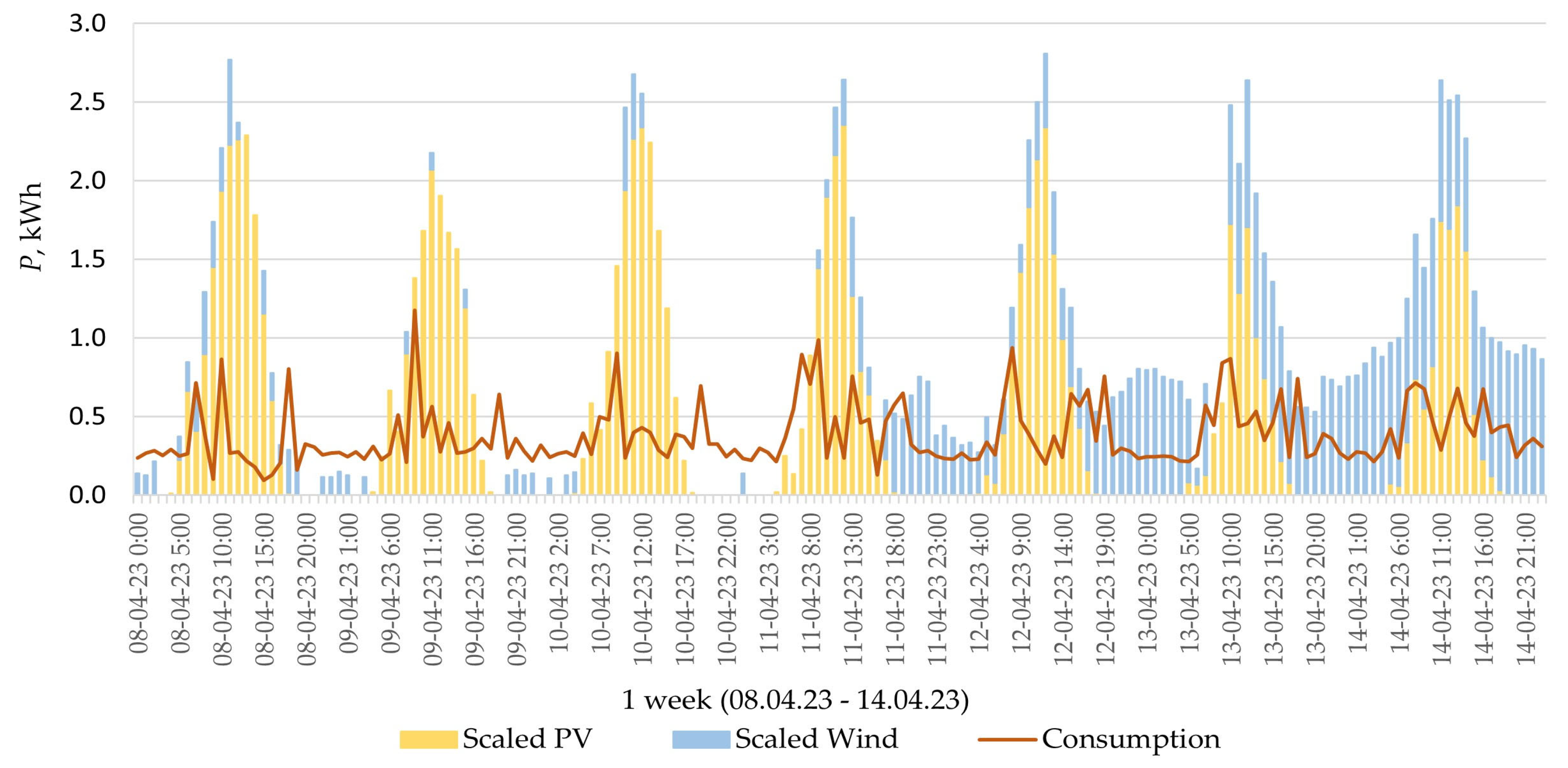
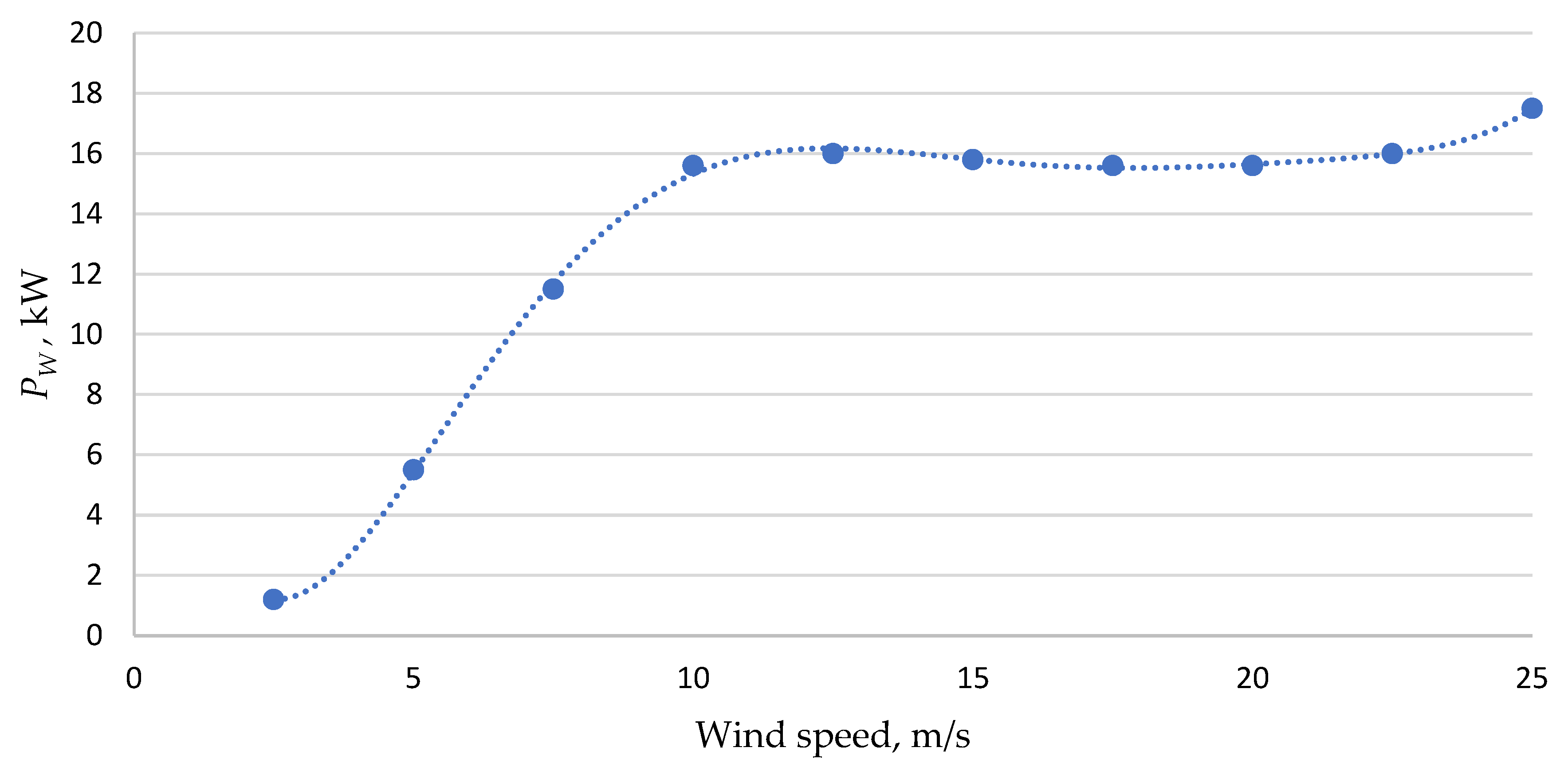
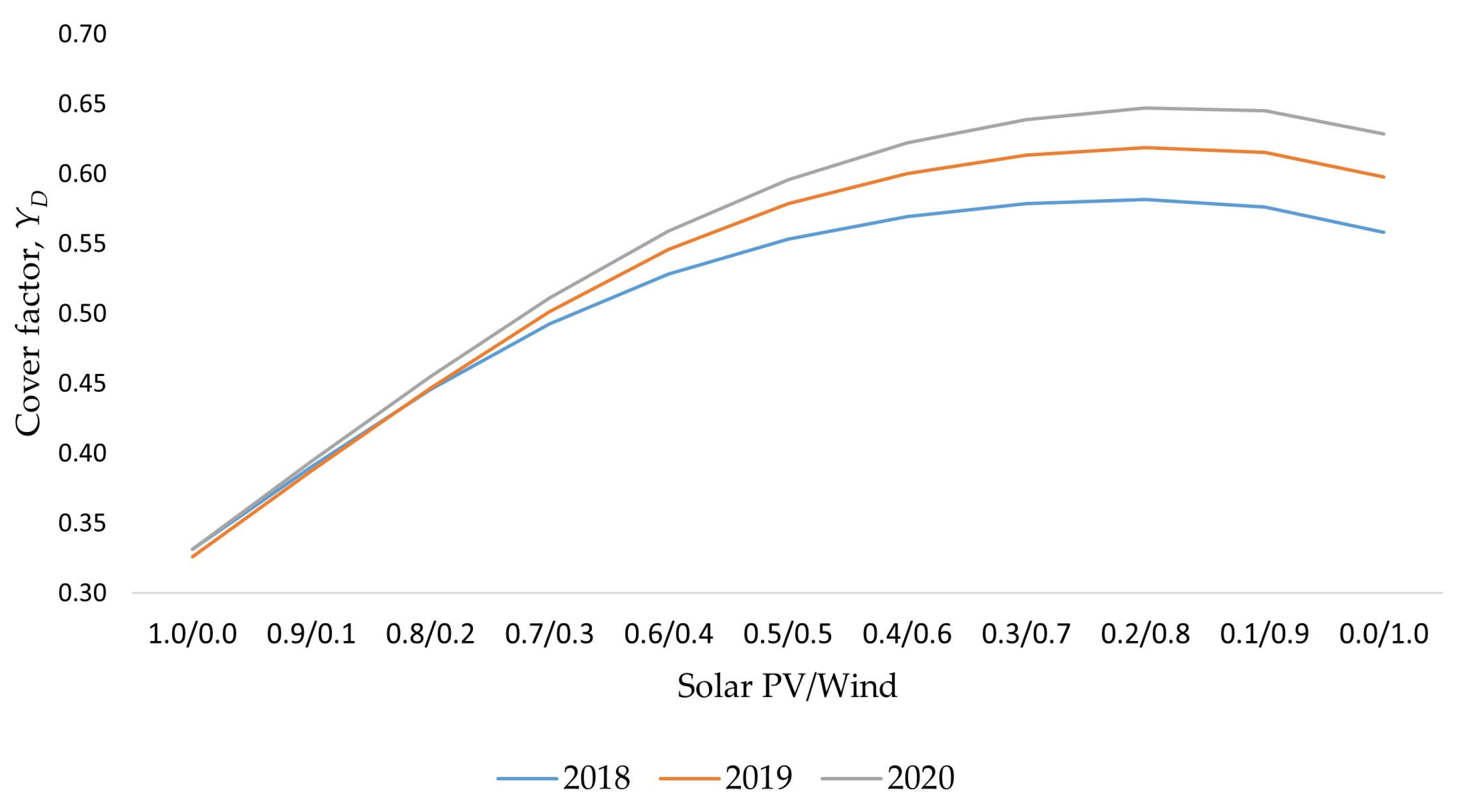
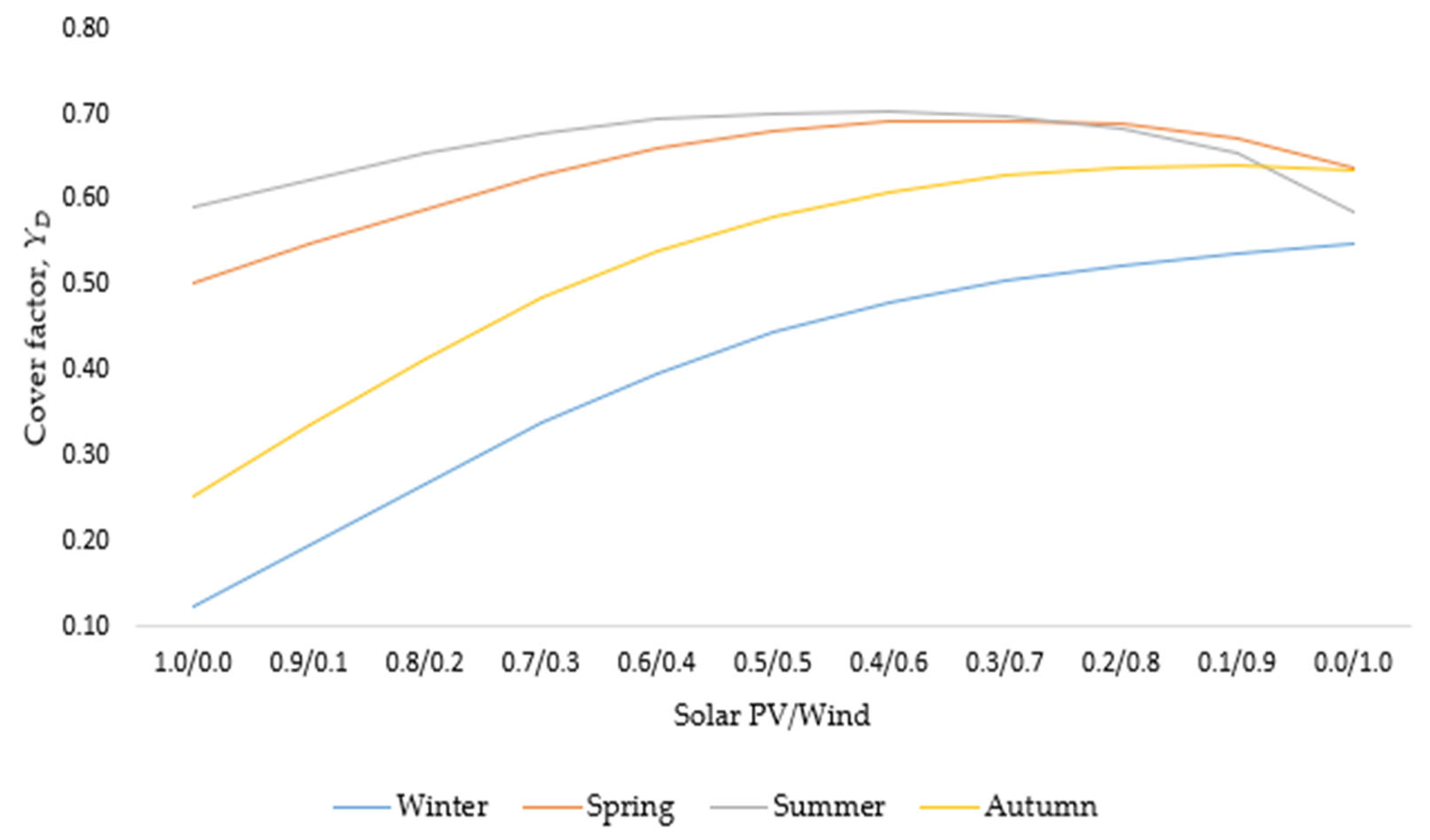
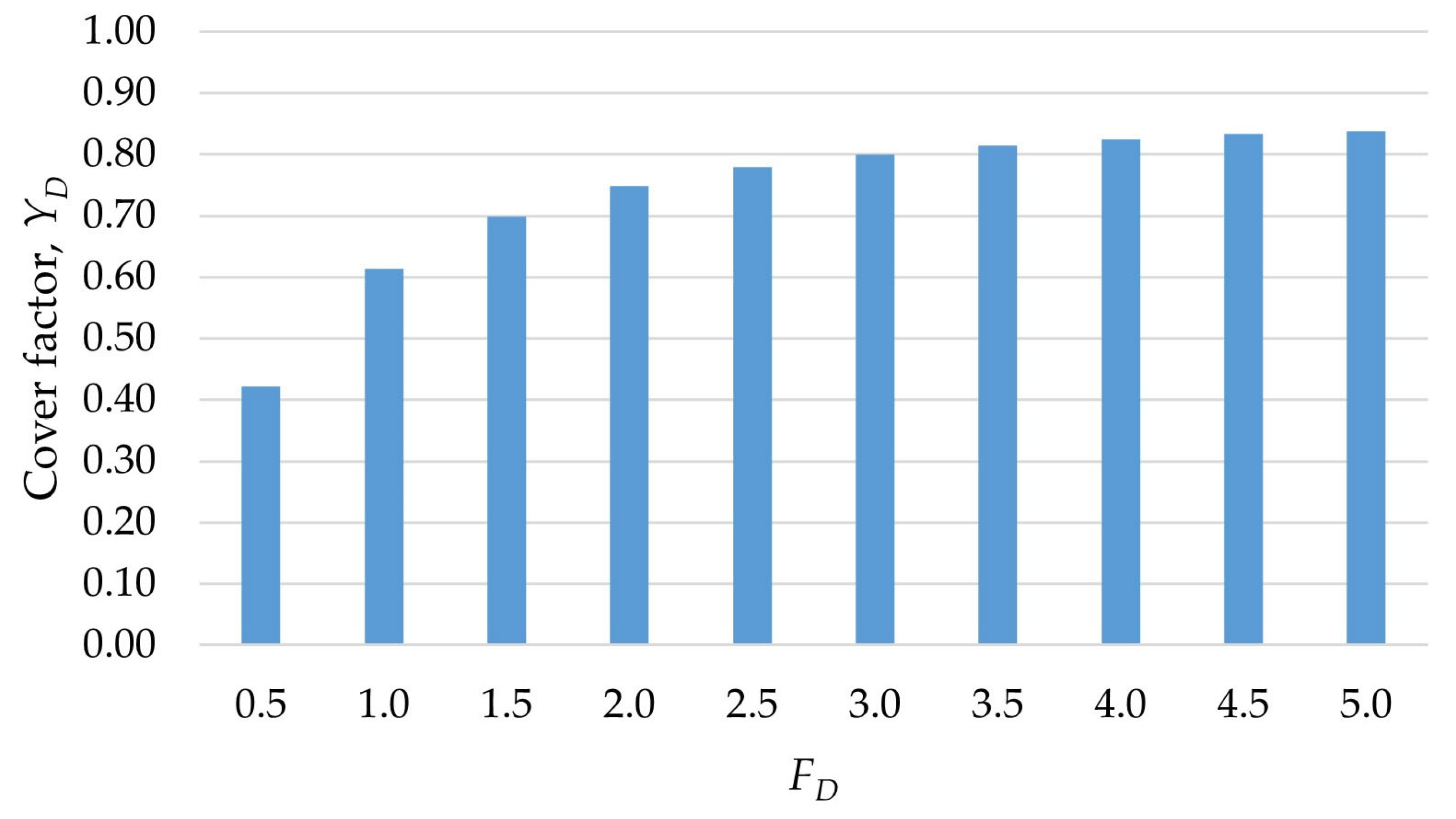
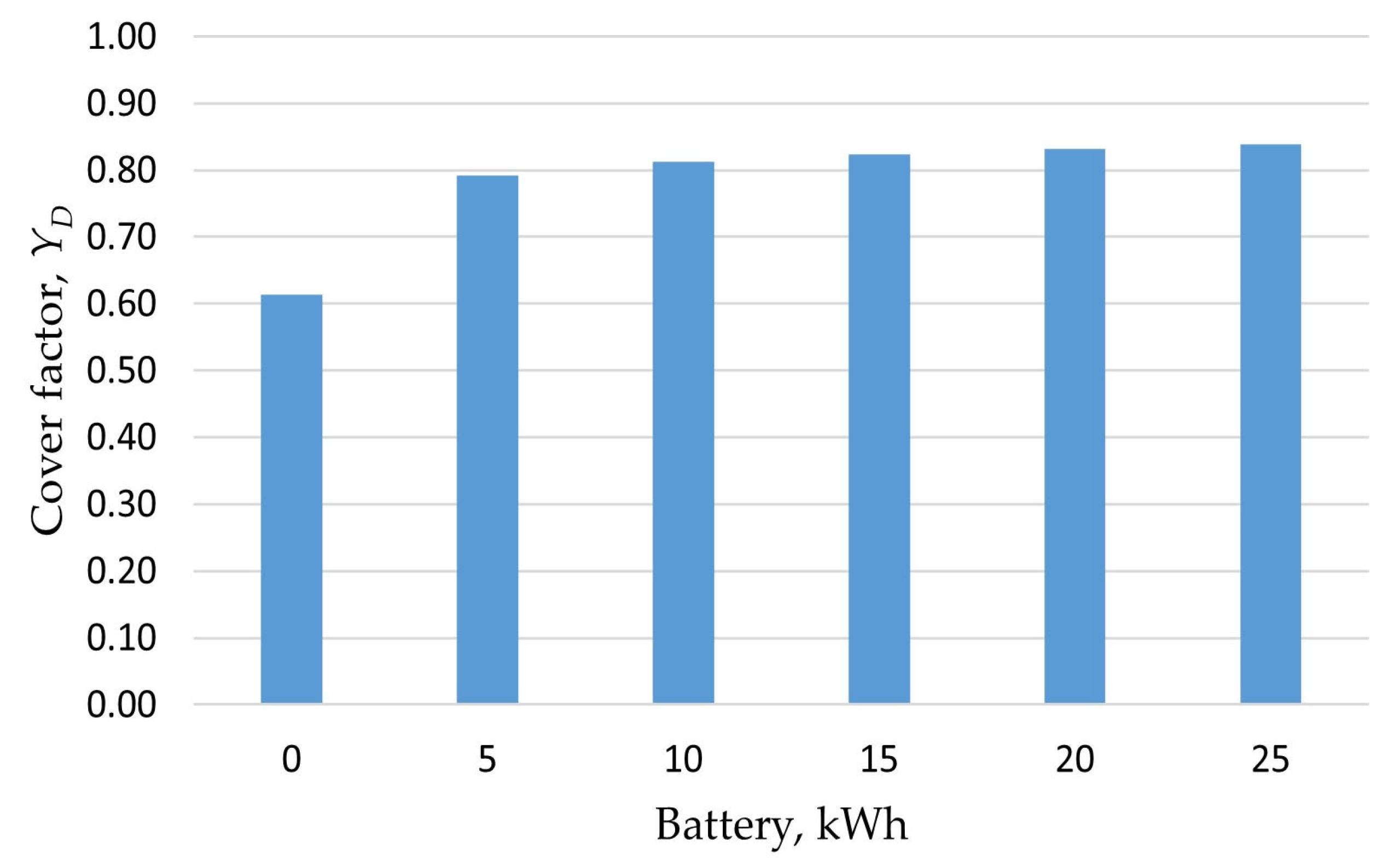
| Study | Methodology | Objectives | Results |
|---|---|---|---|
| Benato et al. [10] | Integration of energy storage with PV systems | Optimize power output stabilization | Virtual power plant model improved power stability |
| Niu and Luo [11] | Economic analysis of distributed PV systems and storage | Evaluate grid adaptability and storage efficiency | Optimized framework enhanced stability and reliability |
| Frank et al. [35] | Analysis of seasonal renewable production in Germany | Study extreme low-power events | Identified increased risk of summer production deficits |
| Fasihi et al. [13] | Green ammonia production with hybrid PV–wind systems | Assess cost competitiveness | Found feasible cost levels for green ammonia by 2040 |
| Year | Capacity CFwind | Factors CFPV | Vavg m/s | Pwind kW | PPV kW |
|---|---|---|---|---|---|
| 2023 | 0.363 | 0.120 | 5.13 | 7.26 | 0.66 |
| 2022 | 0.367 | 0.117 | 5.21 | 7.35 | 0.65 |
| 2021 | 0.382 | 0.116 | 5.37 | 7.65 | 0.64 |
| 2020 | 0.488 | 0.118 | 6.48 | 9.77 | 0.65 |
| 2019 | 0.398 | 0.116 | 5.53 | 7.96 | 0.64 |
| 2018 | 0.346 | 0.121 | 4.91 | 6.91 | 0.66 |
| 2017 | 0.397 | 0.111 | 5.54 | 7.95 | 0.61 |
| 2016 | 0.372 | 0.114 | 5.24 | 7.44 | 0.63 |
| 2015 | 0.443 | 0.117 | 5.96 | 8.87 | 0.64 |
| 2014 | 0.394 | 0.115 | 5.48 | 7.88 | 0.64 |
| Average | 0.395 | 0.116 | 5.49 | 7.90 | 0.64 |
Disclaimer/Publisher’s Note: The statements, opinions and data contained in all publications are solely those of the individual author(s) and contributor(s) and not of MDPI and/or the editor(s). MDPI and/or the editor(s) disclaim responsibility for any injury to people or property resulting from any ideas, methods, instructions or products referred to in the content. |
© 2025 by the authors. Licensee MDPI, Basel, Switzerland. This article is an open access article distributed under the terms and conditions of the Creative Commons Attribution (CC BY) license (https://creativecommons.org/licenses/by/4.0/).
Share and Cite
Meister, R.; Yaïci, W.; Moezzi, R.; Gheibi, M.; Hovi, K.; Annuk, A. Evaluating the Balancing Properties of Wind and Solar Photovoltaic System Production. Energies 2025, 18, 1871. https://doi.org/10.3390/en18071871
Meister R, Yaïci W, Moezzi R, Gheibi M, Hovi K, Annuk A. Evaluating the Balancing Properties of Wind and Solar Photovoltaic System Production. Energies. 2025; 18(7):1871. https://doi.org/10.3390/en18071871
Chicago/Turabian StyleMeister, Riho, Wahiba Yaïci, Reza Moezzi, Mohammad Gheibi, Külli Hovi, and Andres Annuk. 2025. "Evaluating the Balancing Properties of Wind and Solar Photovoltaic System Production" Energies 18, no. 7: 1871. https://doi.org/10.3390/en18071871
APA StyleMeister, R., Yaïci, W., Moezzi, R., Gheibi, M., Hovi, K., & Annuk, A. (2025). Evaluating the Balancing Properties of Wind and Solar Photovoltaic System Production. Energies, 18(7), 1871. https://doi.org/10.3390/en18071871









